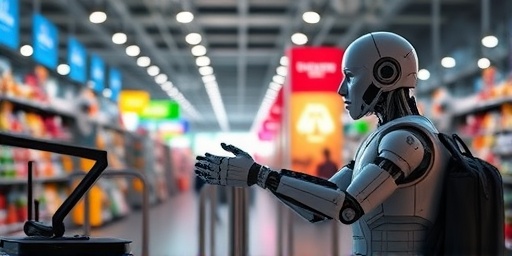In a stark illustration of technology’s double-edged sword, major U.S. companies in the tech sector and retail industries announced over 50,000 job cuts in the first half of 2024 alone, largely attributed to the swift integration of Automation and AI technologies. This wave of layoffs, surpassing previous years’ totals, underscores a troubling trend where efficiency gains come at the expense of human workers, leaving economists and policymakers scrambling to address the fallout.
Tech Giants Slash Thousands of Positions to Fuel AI Expansion
Leading the charge in the tech sector, companies like Google, Microsoft, and Amazon have revealed aggressive workforce reductions as they pivot toward AI-driven operations. Google, for instance, disclosed plans to eliminate 12,000 roles in its engineering and product teams, citing the need to reallocate resources to artificial intelligence projects. ‘AI is not just a tool; it’s reshaping our entire organizational structure,’ stated Sundar Pichai, CEO of Alphabet Inc., during a recent earnings call. This move aligns with broader industry shifts, where Automation tools are handling routine coding, data analysis, and customer support tasks that once required human oversight.
According to a report from the Bureau of Labor Statistics, the tech sector experienced a 4.2% decline in employment from January to June 2024, with AI adoption cited as a primary factor in 60% of surveyed layoffs. Microsoft followed suit by cutting 10,000 jobs across its cloud computing division, emphasizing that AI enhancements in Azure services would streamline workflows and reduce the need for manual intervention. Amazon, not to be outdone, trimmed 9,000 positions in its e-commerce and logistics arms, integrating robotic Automation in warehouses to handle picking, packing, and shipping processes more efficiently.
These job cuts in the tech sector are not isolated incidents but part of a calculated strategy to boost profitability amid economic pressures. Venture capital firm Andreessen Horowitz noted in a recent analysis that AI investments in tech firms surged by 35% year-over-year, enabling companies to automate up to 40% of software development tasks. However, this efficiency comes with human costs: displaced workers, many with specialized skills, face a challenging job market where AI proficiency is increasingly demanded.
Retail Industry Turns to Automation for Survival in Competitive Market
Shifting focus to the retail sector, chains such as Walmart, Target, and Macy’s are deploying AI and automation to combat shrinking margins and evolving consumer behaviors. Walmart announced the closure of 150 underperforming stores and the elimination of 15,000 jobs, replacing them with AI-powered inventory management systems and self-checkout kiosks. ‘Automation allows us to serve customers faster while controlling costs in a high-inflation environment,’ explained Walmart CFO John David Rainey in an investor update.
The retail job cuts are particularly acute in frontline roles. A study by McKinsey & Company estimates that automation could displace up to 800,000 retail positions by 2025, with AI chatbots and predictive analytics taking over customer service and demand forecasting. Target, for example, invested $2 billion in AI technologies last year, leading to the reduction of 8,000 store associate jobs as robotic systems now restock shelves overnight. Macy’s, grappling with e-commerce competition, cut 3,500 roles while expanding its use of AI for personalized shopping recommendations, which has improved sales conversion rates by 25% but at the cost of traditional sales staff.
These developments highlight how retail is leveraging AI to personalize experiences and optimize supply chains. For instance, automated warehouses equipped with AI vision systems can process orders 30% faster than human teams, reducing errors and labor expenses. Yet, the National Retail Federation warns that such rapid adoption exacerbates income inequality, as lower-wage workers in retail are hit hardest by these job cuts.
Economic Ripple Effects Hit Workers and Communities Hard
The combined impact of job cuts in the tech sector and retail industries is sending shockwaves through the U.S. economy. Unemployment rates in tech-heavy states like California and Washington have climbed to 5.1% and 4.8%, respectively, up from 3.5% a year ago, per Federal Reserve data. In retail-dominated regions such as Texas and Florida, similar trends emerge, with over 20,000 positions lost in the sector since March 2024.
Economists point to a broader pattern: automation and AI are accelerating structural unemployment, where workers struggle to transition to new roles. A World Economic Forum report projects that by 2027, AI could automate 85 million jobs globally, but only create 97 million new ones—leaving a net gap that disproportionately affects the U.S. service economy. In personal stories emerging from layoffs, former Amazon warehouse employee Maria Gonzalez shared, ‘I trained the robots that replaced me. Now, I’m back in school learning coding, but it’s tough at 45.’
Communities are feeling the strain too. Cities like Seattle and Austin, hubs for tech innovation, report increased demand for unemployment benefits, while retail towns in the Midwest see declining local spending as job losses mount. The U.S. Chamber of Commerce estimates that these job cuts could shave 0.5% off GDP growth in 2024 if unchecked, prompting calls for federal intervention.
Experts Debate AI’s Role in Reshaping the Workforce
As automation and AI propel job cuts across sectors, industry experts offer divided perspectives on the future. Dr. Fei-Fei Li, a Stanford AI pioneer, argues in a recent op-ed that ‘while AI displaces routine jobs, it amplifies human creativity in higher-value tasks.’ She advocates for upskilling programs, noting that tech firms like IBM have already retrained 20,000 employees in AI ethics and machine learning.
Conversely, labor economist Carl Benedikt Frey from Oxford University warns of a ‘hollowing out’ effect, where middle-skill jobs in tech and retail vanish fastest. In a panel discussion hosted by CNBC, Frey stated, ‘Without policy changes, AI-driven job cuts could widen the wealth gap, as gains accrue to shareholders rather than workers.’ Supporting this, a Gartner survey reveals that 75% of executives plan further automation investments, potentially leading to 1 million U.S. job losses by 2026.
Positive voices highlight opportunities: AI could spawn roles in data annotation, algorithm auditing, and ethical AI governance. Companies like Salesforce are piloting ‘AI co-pilot’ programs, where humans collaborate with machines, preserving jobs while enhancing productivity. Nonetheless, the consensus is clear—adaptation is key, with calls for government subsidies on retraining to mitigate the pain of these transitions.
Looking ahead, the trajectory of automation and AI in the tech sector and retail promises continued disruption. Policymakers are eyeing initiatives like the proposed AI Workforce Act, which would allocate $500 million for reskilling programs targeting affected workers. Unions, including the AFL-CIO, are pushing for ‘robot taxes’ to fund social safety nets, ensuring that technological progress benefits society broadly. As companies race to automate, the real challenge lies in balancing innovation with inclusive growth, preventing a future where job cuts define the AI era rather than opportunity.









